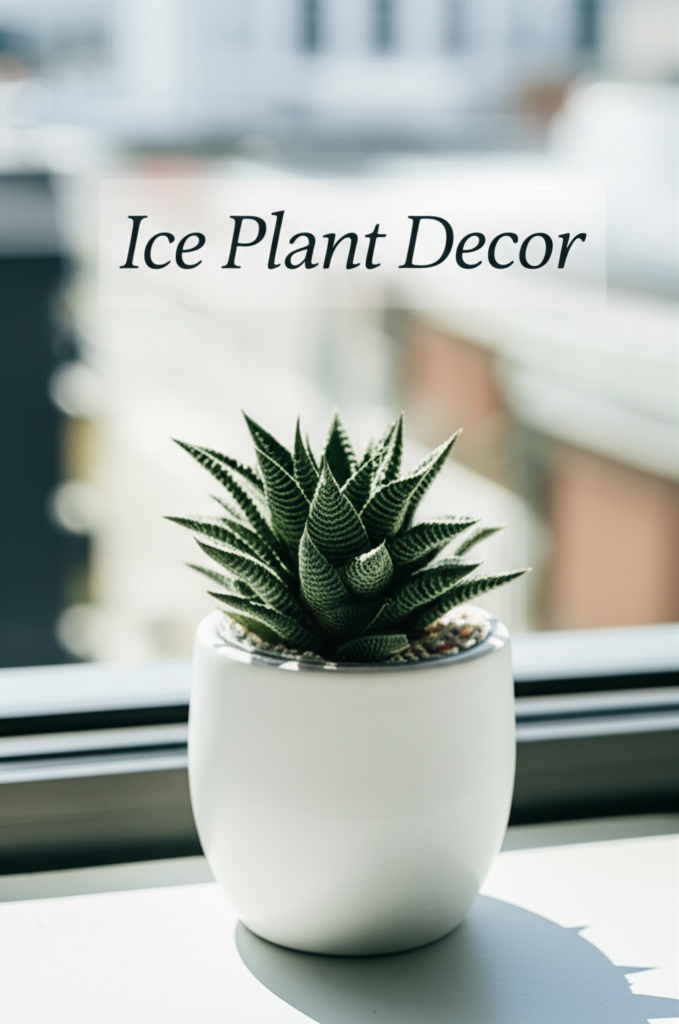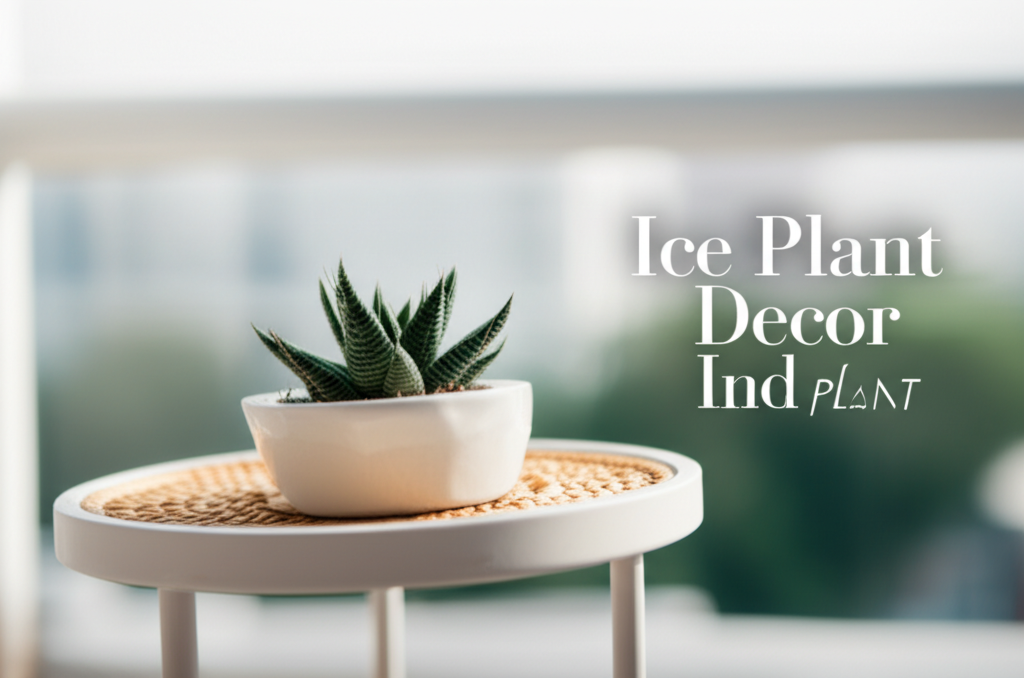Introduction: The Allure of the Ice Plant Succulent Indoors
The world of indoor gardening is constantly evolving, with succulents leading the charge in popularity due to their low-maintenance nature and striking beauty. Among these resilient wonders, the Ice Plant succulent (family Aizoaceae) stands out. Known for its mesmerizing, ice-crystal-like epidermal cells that shimmer in the light, the Ice Plant offers a unique aesthetic that can transform any indoor space. This article will delve into the creative possibilities of incorporating Ice Plant succulents into indoor balcony and tabletop arrangements, focusing on both visual appeal and practical considerations for their care. From understanding their specific needs to designing miniature oases, we’ll explore how these fascinating plants can become the focal point of your home décor.
Understanding the Ice Plant Succulent: More Than Just Pretty Crystals

Before we embark on creative layout design, a foundational understanding of the Ice Plant’s needs is crucial for its thriving. These succulents, often referred to as “mesembs” (short for Mesembryanthemaceae, their former family), are native to arid regions of Southern Africa. This heritage dictates their preferred growing conditions.
Key Characteristics of Ice Plant Succulents:
- Foliage: Their defining feature is the presence of translucent, bladder-like cells (papillae) covering their leaves and stems. These cells help collect moisture from the air and protect the plant from intense sunlight.
- Growth Habit: Ice Plants exhibit diverse growth habits, including trailing, clumping, and spreading. This variety offers ample opportunity for creative arrangements.
- Flowering: Many species produce vibrant, daisy-like flowers, often opening during the day and closing at night, adding another layer of visual interest.
- Water Needs: They prefer infrequent but thorough watering. Overwatering is their greatest enemy, leading to root rot.
- Light Requirements: Ice Plants thrive in bright, indirect sunlight. Too much direct sun can scorch their delicate cells, while insufficient light can lead to leggy growth and loss of their characteristic sparkle.
- Soil: Well-draining soil is paramount. A succulent or cactus mix, often amended with perlite or coarse sand, is ideal.
- Temperature: They prefer warm temperatures during the growing season and cooler conditions during their dormant period, typically in winter.
Key Facts/Comparison: Ice Plant Succulent Varieties for Indoor Display
The Aizoaceae family is vast, and several genera are commonly referred to as “Ice Plants” and are well-suited for indoor cultivation. Choosing the right variety can significantly impact your design.
| Common Name | Genus | Key Features | Growth Habit | Suitability for Table Layouts |
|---|---|---|---|---|
| Living Stones | Lithops | Resemble pebbles, highly adapted to arid conditions, solitary or in small clusters. | Clumping/Upright | Excellent for miniature desert scenes. |
| Dew Plant / Baby Toes | Fenestraria rhopalodium | Leaf tips have window-like openings, resembling toes. | Clumping/Spreading | Great for creating textured ground cover in arrangements. |
| Carpobrotus | Carpobrotus | Fleshy, triangular leaves, often with vibrant flowers. Some varieties are groundcovers. | Trailing/Spreading | Ideal for cascading elements in hanging baskets or spilling over pot edges. |
| Delosperma | Delosperma | Known for abundant, colorful flowers, often with flattened leaves. | Clumping/Trailing | Adds pops of color and can trail gracefully. |
| Pleiospilos | Pleiospilos | Resemble split rocks, thick, often triangular leaves. | Clumping/Upright | Adds interesting sculptural elements to arrangements. |
Designing Your Ice Plant Succulent Balcony and Table Layouts
The beauty of Ice Plant succulents lies in their versatility. They can be incorporated into a wide range of aesthetic styles, from minimalist and modern to bohemian and whimsical. The key is to consider the container, the accompanying plants, and the overall environment.
Container Choices for Impact:
- Ceramic Pots: Offer a classic and elegant look. Consider glazed finishes for a pop of color or matte finishes for a more understated elegance.
- Terracotta Pots: Their porous nature allows for good air circulation and helps prevent overwatering. They also develop a beautiful patina over time.
- Glass Terrariums: While many succulents prefer open containers, some Ice Plants can thrive in open-top terrariums with excellent drainage. This allows for a full view of the root system and accompanying elements.
- Wooden Planters: Introduce a natural, rustic feel. Ensure they are treated for moisture resistance or have an internal liner.
- Repurposed Items: Old teacups, vintage tins, or even hollowed-out books can add a unique, personal touch to your arrangements. Ensure adequate drainage is added if necessary.
Creative Table Layout Ideas:
- The Miniature Desert Landscape: Combine various Ice Plant species like Lithops and Fenestraria in a shallow, wide planter. Use coarse sand, small pebbles, and driftwood to mimic a desert environment. Add a few larger stones for dramatic effect.
- The Cascading Jewel Box: Utilize trailing Ice Plants like certain Carpobrotus or Delosperma varieties in hanging baskets or elevated planters on your balcony. Allow them to spill over the edges, creating a waterfall of shimmering foliage.
- The Monochromatic Marvel: Focus on Ice Plants with similar color palettes, such as those with silvery-grey or pale green leaves. Arrange them in minimalist ceramic pots of varying heights for a sophisticated, serene display.
- The Textured Tapestry: Mix Ice Plants with different leaf textures and shapes. Combine the smooth, fleshy leaves of one variety with the more crystalline surfaces of another for a visually dynamic composition.
- The “Living Art” Arrangement: Use a shallow dish or a decorative tray as your base. Arrange a few focal Ice Plants with interesting shapes, interspersed with small, decorative stones, polished glass, or even miniature figurines to create a living sculpture.
Balcony Considerations:
- Sun Exposure: Assess the amount of direct sunlight your balcony receives throughout the day. If it’s intense, opt for varieties that can tolerate brighter light or place them where they receive dappled shade during the hottest part of the day.
- Wind Protection: Strong winds can dry out succulents quickly. Consider placing your arrangements in a more sheltered spot or using heavier containers to prevent them from tipping over.
- Vertical Gardening: Balcony spaces often benefit from vertical solutions. Consider tiered planters or wall-mounted succulent gardens featuring cascading Ice Plants.
Caring for Your Ice Plant Succulent Arrangements: Nurturing the Sparkle
Even the most beautifully designed arrangement will falter without proper care. The unique needs of Ice Plant succulents require attention to detail.
Watering Wisdom:
The golden rule for all succulents, and especially Ice Plants, is to water only when the soil is completely dry. To check, stick your finger about an inch or two into the soil. If it feels dry, it’s time to water. When you do water, do so thoroughly, ensuring water drains from the bottom of the pot. Avoid misting, as this can lead to fungal issues and doesn’t adequately hydrate the roots.
Light, the Illuminator:
Most Ice Plant succulents thrive in bright, indirect light. A south- or east-facing window is often ideal. On a balcony, position them where they receive several hours of morning sun but are protected from the harsh afternoon sun, especially in hotter climates. If your plants start to stretch (etiolate) or lose their vibrant coloration, they may need more light.
Soil and Drainage: The Foundation of Health:
As mentioned, well-draining soil is non-negotiable. If you’re potting up a new arrangement or repotting existing plants, use a commercial succulent or cactus mix. You can further improve drainage by adding perlite, pumice, or coarse sand in a ratio of about 1:1 with the potting mix.
Fertilizing: A Gentle Approach:
Ice Plant succulents are not heavy feeders. A light feeding during the growing season (spring and summer) with a diluted succulent fertilizer can be beneficial. Opt for a balanced fertilizer with lower nitrogen content. Avoid fertilizing during their dormant period in winter.
Repotting: Giving Them Room to Grow:
Succulents generally prefer to be slightly root-bound. Repotting is usually only necessary every 2-3 years, or when you notice the plant has outgrown its container significantly or the soil has become compacted and drains poorly. The best time to repot is at the beginning of the growing season.
Pest and Disease Management: Prevention is Key:
The most common issue with succulents is overwatering, which leads to root rot. Ensure excellent drainage and proper watering techniques. Pests like mealybugs and spider mites can occasionally be an issue. Inspect your plants regularly, and if you spot pests, treat them with a horticultural oil or insecticidal soap, ensuring to reach all affected areas.
Steps/Pros-Cons: Ice Plant Succulent Arrangement Maintenance
| Action | Pros | Cons |
|---|---|---|
| Watering (when dry) | Promotes healthy root growth, prevents rot, mimics natural conditions. | Overwatering leads to root rot and plant death. Underwatering can cause dehydration. |
| Providing Bright, Indirect Light | Encourages compact growth, vibrant coloration, and the development of “ice” crystals. | Too much direct sun can scorch leaves. Insufficient light leads to etiolation (stretching). |
| Using Well-Draining Soil | Prevents waterlogging and root rot, essential for succulent health. | Poorly draining soil is detrimental and difficult to correct once planted. |
| Fertilizing Sparingly (during growing season) | Provides essential nutrients for healthy growth and flowering. | Over-fertilizing can burn roots and lead to unnatural, weak growth. |
| Repotting (every 2-3 years) | Provides fresh nutrients and prevents rootbound conditions. | Can shock the plant if done incorrectly; a delicate process for some varieties. |
| Pest Inspection and Treatment | Early detection and treatment prevent widespread infestation. | Chemical treatments can be harsh; natural methods may require persistence. |
Incorporating Other Elements: Enhancing Your Display
To elevate your Ice Plant succulent arrangements from simple potted plants to captivating displays, consider incorporating complementary elements.
Companion Plants:
- Other Succulents: Pair Ice Plants with other succulents that have similar light and water needs, such as Echeverias, Sedums, or Haworthias. Their varied forms and colors can create stunning contrasts.
- Air Plants (Tillandsia): For a more ethereal look, consider incorporating air plants among your succulents. They don’t require soil and can add a touch of delicate greenery or structure.
- Cacti: Small, slow-growing cacti can add a sculptural element and a different textural dimension to your arrangements, especially in miniature desert scenes.
Decorative Accents:
- Stones and Pebbles: Use various sizes, shapes, and colors of decorative stones and pebbles to mimic natural landscapes, create pathways, or add weight and stability to your pots.
- Sand: Different grades of sand can be used to create layers or a top dressing that enhances the visual appeal and aids in drainage.
- Driftwood and Twigs: Small pieces of driftwood or interesting twigs can add a rustic or naturalistic touch, providing a sense of scale and visual interest.
- Moss: Dried moss can be used sparingly as a top dressing to add color and texture, but be mindful that it can retain moisture, so use it judiciously around succulents.
- Miniature Figurines: For a whimsical touch, small animal figurines, tiny houses, or fairy garden elements can add a narrative to your succulent displays.
Conclusion: Your Personal Succulent Sanctuary
Creating an indoor balcony or tabletop layout with Ice Plant succulents is a rewarding creative endeavor. By understanding their unique needs and embracing their stunning visual appeal, you can transform ordinary spaces into miniature sanctuaries of natural beauty. Whether you opt for a minimalist arrangement or a densely packed miniature landscape, the shimmering allure of the Ice Plant succulent is sure to bring a touch of magic and tranquility to your home. Experiment with different containers, plant combinations, and decorative elements to craft a display that is uniquely yours, a testament to the resilience and captivating charm of these remarkable plants.


